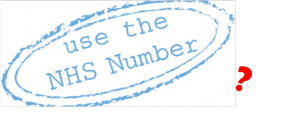 Here’s a brief summary of a question put to me by Vin Diwakar, stimulated by the Children and Young People’s Health Outcomes Forum Summit 2014, and my response.
Here’s a brief summary of a question put to me by Vin Diwakar, stimulated by the Children and Young People’s Health Outcomes Forum Summit 2014, and my response.
Importantly, in the original discussion I made an error; the NHS number does in fact have a check number. For more info, and an explanation, read on.
The question was: Why do hospitals use their own hospital numbers instead of their NHS number if the NHS number is a unique identifier?
As with many simple questions, the answer is complicated and multifactoral. Interestingly, from the way that folk have responded – the response “we should just make it happen” is popular, valid, but also needs to be thought through.
There are two important things we need to look at here; what I’ll call “checking”, and short term memory.
I work in a big, busy hospital. Our outpatient department handles about 150,000 attendances a year, our emergency department about 45,000 attendances per year.
About 8 years ago we altered our numbering in conjunction with introducing a new patient administration system – partly so that we could identify those from the new era, and partly so we could start from a sort of “zero” point again; we went from the letter C followed by six numbers, to the letter L followed by seven numbers. However, the first of those numbers was 1, and so, in a way, the number of changing digits was six. Over the past few years it is now reached the mid 1,300,000s for new registrations.
If I’m doing a ward round and we stop to look at an X-ray, I’ll sit at the computer and, if I’m lucky, someone will read the number to me. Immediately there are some things that I can tell from the number – intuitively if not explicitly.
If they start the number with “Z” I know they’re not looking at the right number.
If they give me an L then a number other than 1, there is a problem.
If they give me a C number with anything other than six digits, or an L number with anything other than 7 digits, there’s a problem.
If we’re talking a bout a three month old and they say “L10” I think – that’s odd, an L10 would have been given out years ago…
Some of these bits of knowledge are more specialist – ie geeky – than others, but they’re all checks and balances. For example, and a little more generic, in the UK if someone tries to give you a telephone number that starts with the number 9, or tries to give you a postcode which doesn’t follow the sequence letter(s)-number-number-letters, you know they’re probably wrong. (Dates are another good example of this)
Now, here’s an even geekier bit. Some numbering systems are designed with a internal checking system. For example, the ISBN number, used for identifying books, includes a check digit at the end. In short, some mathematics is done on the identifying bit of number, which produces one or more extra digits. If there is an error then it is obvious (to software) that this cannot be a correct ISBN, so it doesn’t even bother looking. It’s a great example of identifying the error at the point at which it is made, rather than doing a complex correction later. Incidentally, your credit card number has the same sort of thing embedded.
The bit I discovered this evening, when reading around this, is that the NHS number does in fact include a check number – there’s a wonderfully complex description (not explanation) here. (Good luck with the modulo 11 bit) But the thing is, it’s not possible for me to spot – as I write it down – whether or not it’s right, any more than I can spot a correct credit card number or ISBN. (There are geeks who can do this as a party trick, thankfully not the sorts of party I get invited to…)
Now then, short term memory. Comfortably you can remember a six digit number as you turn a page. Seven is stretching it a bit. Over this and you’ve really into expert memory territory. Note that there some strings you may think you can remember that are longer than 6 items – so a long surname, or a sentence. But, they’re riddled with rules you’ve spent a lifetime learning; remove the rules – make the surname “kljafdwaerjk” and you’ll take two turns of the page.
Of course you know where this is going. The NHS number is 10 digits long. If we used it in our paper-based systems we would introduce error after error. Every time we turned a page, we’d have to check back at least twice just to have a shot at getting the whole ten digit number onto the next page. There would be so many transcription errors that we’d pick up late, and usually only after we attempted to use it in a computer system to access other information. We’d spend hours unpicking these errors – back through pages of notes, altering the number, so that it did not get unwittingly transmitted forwards.
So, why don’t we use the NHS number instead of local hospital numbers? Because, at the moment, in the mostly pre-electronic era it is too risky, because humans can’t cope with ten digits which they can’t easily sense check each time they write.
But in the fully electronic era? Now there’s a thought
– Ian Wacogne